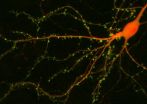"These nanoparticles' lack of toxicity in mice is a good sign that they'll behave well in humans," said Sanjiv Sam Gambhir, MD, PhD, professor of radiology and senior author of the study, which will be published April 20 as the featured paper in Science Translational Medicine.
"Early detection of any cancer, including colorectal cancer, markedly improves survival," said Gambhir. For example, the widespread use of colonoscopy has significantly lowered colon-cancer mortality rates, he said. "But colonoscopy relies on the human eye. So this screening tool, while extremely useful, still misses many cancer lesions such as those that are too tiny, obscure or flat to be noticed."
A promising way to catch cancer lesions early is to employ molecular reporters that are attracted to cancer-lesion sites. One method in use involves fluorescent dyes coupled with antibodies that recognize and bind to surface features of cancer cells.
But that approach has its drawbacks, said Gambhir, who is the director of the Molecular Imaging Program at Stanford. The body's own tissues also fluoresce slightly, complicating attempts to pinpoint tumor sites. Plus, the restricted range of colors at which antibody-affixed dyes fluoresce limits the number of different tumor-associated features that can be simultaneously identified. Some versions of this approach have also proved toxic to cells.
The new study is the first-ever successful demonstration of the safety of a new class of agents: tiny gold balls that have been coated with materials designed to be detected with very high sensitivity, then encased in see-through silica shells and bound to polyethylene glycol molecules to make them more biologically friendly. Molecules that home in on cancer cells can be affixed to them. The resulting nanoparticles measure a mere 100 nanometers in diameter.
The materials surrounding the nanoparticles' gold centers have special, if subtle, optical properties. Typically, light bounces off of a material's surface at the same wavelength it had when it hit the surface. But in each of the specialized materials, about one ten-millionth of the incoming light bounces back in a pattern of discrete wavelengths characteristic of that material. The underlying gold cores have been roughed up in a manner that greatly amplifies this so-called "Raman effect," allowing the simultaneous detection of many different imaging materials by a sensitive instrument called a Raman microscope.
Nanoparticles of this type were originally used in currency inks, to make them difficult to counterfeit. But Gambhir's laboratory, in collaboration with Oxonica Materials, a small company owned by the Boston-based Cabot Corp., has adapted them for biological use.
"Photoimaging with these nanoparticles holds the promise of very early disease detection, even before any gross anatomical changes show up, without physically removing any tissue from the patient," said Gambhir, who is also the Virginia and D.K. Ludwig Professor of Cancer Research. But until now, there has been no proof these particles won't be toxic. The potential effects of anything so small it can be taken up by cells can't be taken for granted.
To see if this concern could be put to rest, the investigators administered the nanoparticles to two groups of mice, each consisting of 30 male and 30 female animals, and assessed toxicity in a variety of ways. In each case, the dose was 1,000 times as large as would be required to get a clear signal from the nanoparticles.
The first group of 60 mice received the nanoparticles rectally. The researchers followed up with a series of measurements at five different time points ranging from five minutes to two weeks. They monitored the test animals' blood pressure, electrocardiograms and white-blood-cell counts. They examined several tissues for increases in the expression of antioxidant enzymes or pro-inflammatory signaling proteins, which would suggest physiological stress on the animals' cells. They stained tissues with dyes that flag dying cells.
These inspections yielded virtually no signs of stress to any tissues, and none at all by two weeks after the time of administration. Importantly, the team inspected tissues via electron microscopy to find out where the gold-containing particles had lodged themselves. They found no gold anywhere outside the bowel, indicating that the nanoparticles remained confined to that organ and thus, when rectally administered, posed no threat of systemic toxicity. Furthermore, the nanoparticles were quickly excreted.
"That lowers the bar for testing of these agents by the Food and Drug Administration for use in detecting colorectal cancers, because it addresses worries about systemic toxicity," Gambhir said.
However, even if the nanoparticles had moved beyond the bowel, it seems they would have caused no systemic problems. On administering the nanoparticles intravenously to the second group of 60 mice, the investigators once again found scant signs of inflammation or other evidence of toxicity — and virtually none by two weeks after administration. The intravenously administered nanoparticles were rapidly sequestered by scavenger cells resident in organs such as the liver and spleen.
This opens the door to human tests of intravenous injections of these nanoparticles to search for tumors throughout the body. "We can attach molecules targeting breast, lung or prostate cancer to these spheres," Gambhir said. In the study, the researchers did test nanoparticles conjugated to one such molecule: a small protein snippet, or peptide, known to be attracted to tumor cells. Again, no toxic effects were observed.
Gambhir's group is now filing for FDA approval to proceed to clinical studies of the nanoparticles for the diagnosis of colorectal cancer.
###
The study was sponsored by the National Cancer Institute and the Canary Foundation. Much of the hands-on work was performed by lead author Avnesh Thakor, MD, PhD, now doing a radiology residency at Cambridge University. Other Stanford co-authors were veterinary pathologist Richard Luong and research assistant Pauline Chu, both of the Department of Comparative Medicine; radiology assistant professor Ramasamy Paulmurugan, PhD, and visiting associate professor Tarik Massoud, MD, PhD; Frank Lin, MD, a former resident in Gambhir's lab; materials science and engineering professor Robert Sinclair, PhD, and graduate student Paul Kempen; and postdoctoral researcher Cristina Zavaleta, PhD, of Gambhir's laboratory.
More information about Department of Radiology, which also supported the work, is available at http://radiology.stanford.edu.
The Stanford University School of Medicine consistently ranks among the nation's top medical schools, integrating research, medical education, patient care and community service. For more news about the school, please visit http://mednews.stanford.edu. The medical school is part of Stanford Medicine, which includes Stanford Hospital & Clinics and Lucile Packard Children's Hospital. For information about all three, please visit http://stanfordmedicine.org/about/news.html.
PRINT MEDIA CONTACT: Bruce Goldman at (650) 725-2106 (goldmanb@stanford.edu)
BROADCAST MEDIA CONTACT: M.A. Malone at (650) 723-6912 (mamalone@stanford.edu)
END

